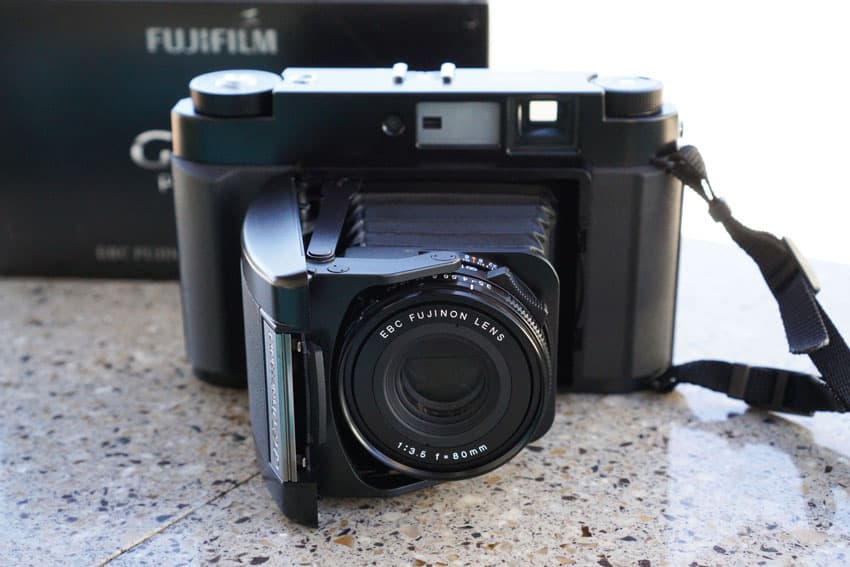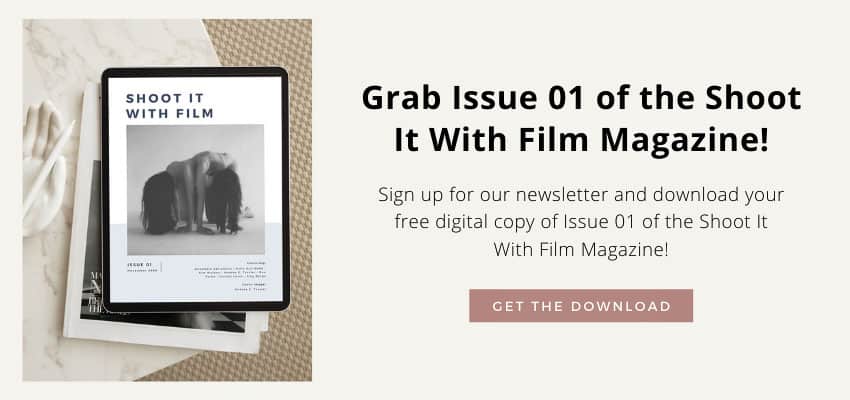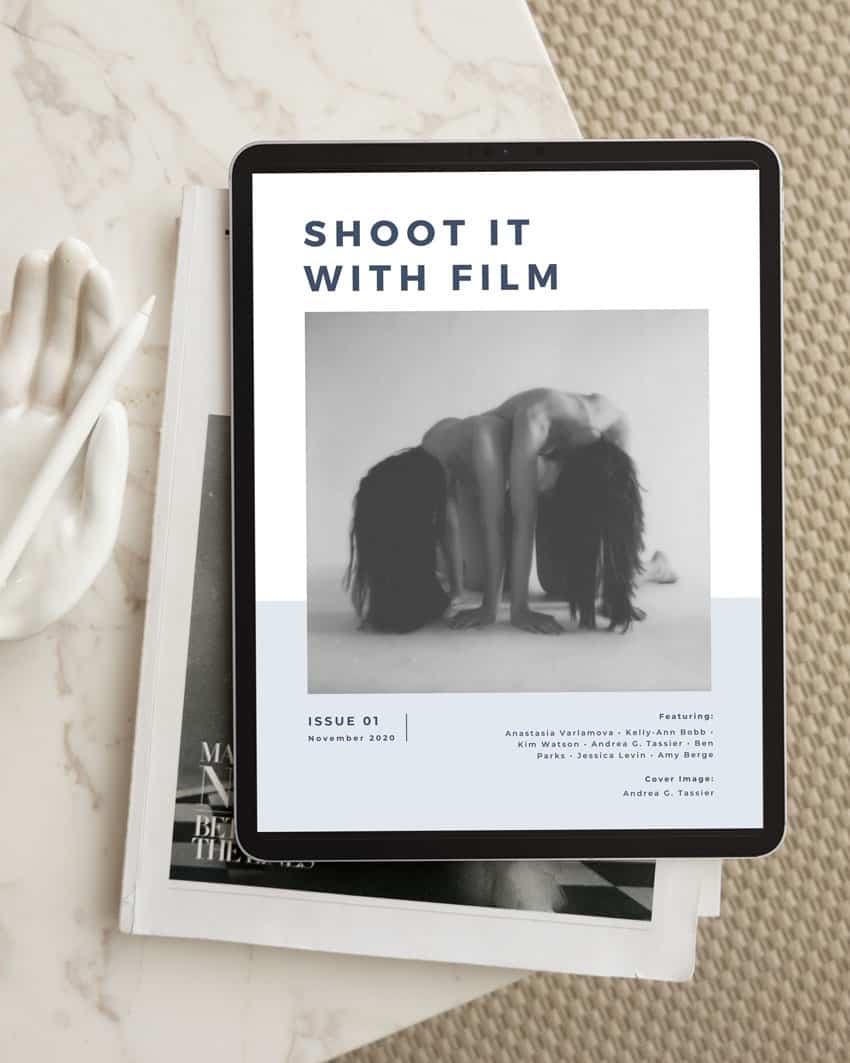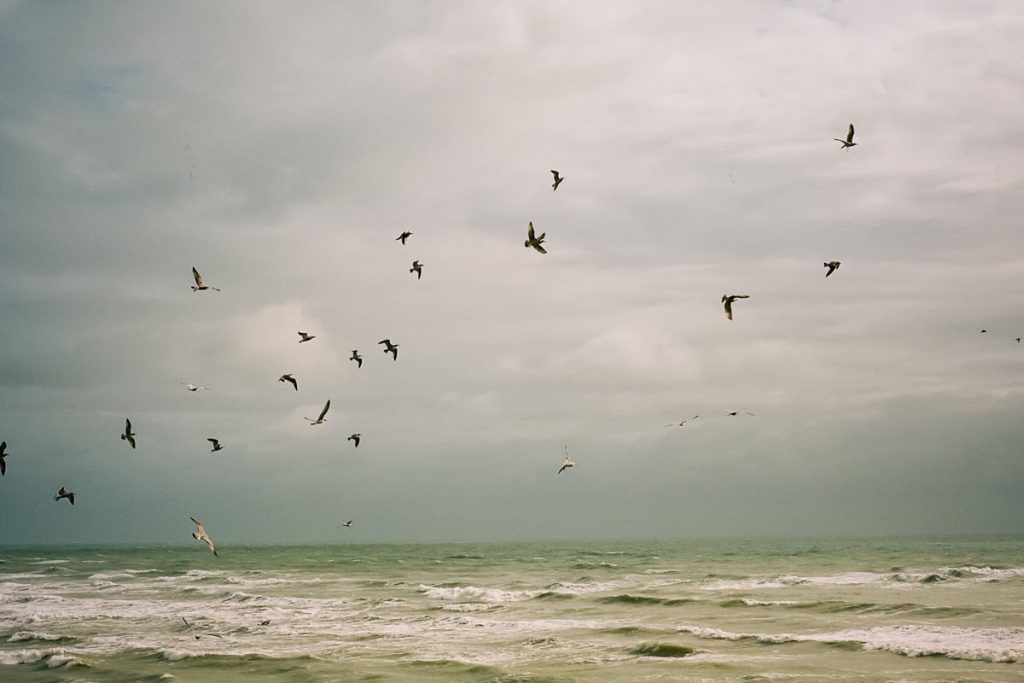
If you’re looking for a compact, high-quality medium format camera, the Fujifilm GF670 is such a great option.
I picked it up a few years ago, and it has become my go-to camera whenever I want to shoot medium format. It’s a fantastic travel camera, easy to use, and produces stunning images.

An Overview of the Fujifilm GF670
Fujifilm’s GF670, also known as the Voigtländer Bessa III, is a folding rangefinder that shoots in either 6×6 or 6×7 format.
It’s similar in style to Fujifilm’s GA645 line of cameras, but with a folding bellows system for the lens.
If you want some more information on rangefinders and how to use them, you can learn about that here.
So let’s dive into a few of the pros and cons of the Fuji GF670 and the technical details.
Find the Fujifilm GF670 at KEH Camera or on eBay.



Reasons to Love the Fujifilm GF670
1. It’s Compact!
It’s tough to find a medium format camera in a small package, especially one that shoots 6×7.
Other popular 67 cameras like the Pentax 67 or the Mamiya RB67 are known for their bulkiness and how heavy they are to carry around, but the GF670 is exactly the opposite.
When the camera is open and your shooting, it’s only 7″ x 4.3″ x 5.4″ and about 2 lbs. Compare that to the Mamiya RB67 which is almost 6 pounds!
And it folds down to about 2.5” thick, so it’s really easy to travel with and pack away in a camera bag.



2. Beautiful Build Quality and Shooting Experience
The Fuji GF670 is a gorgeous camera. It has a modern, sleek design with a super durable feel. I’ve shot this camera for a few years now, and the bellows still look brand new. Just really well made and a beautiful piece of machinery.
It’s also very mechanical. There is no LCD screen or digital settings. Setting the aperture, focus, and shutter speed are all done with knobs and dials. So if you like a very classic, mechanical film experience, this camera is it.
The GF670 was in production from about 2009 to 2014, and many of the newer film cameras like this feel like digital cameras that just take film (like the Nikon F6).
But not the GF670. Because it is so mechanical and keeps that folded bellows design, the shooting experience is unmistakably film in the absolutely best way.


3. The Lens is Sharp
The GF670 has a fixed Fujinon EBS 80mm f/3.5 lens, and it is a dang good lens. I have found it to be very sharp, even at f/3.5, and just a beautiful lens that really makes your images shine.
Note: There is also a wide version of this camera, the GF670W, with a fixed 55mm lens. The wide version does not fold and does not have bellows. Instead, the lens is bolted to the front of the camera.


4. It’s So Quiet!
When I say the GF670 is quiet, I mean QUIET! Like the shutter is almost completely silent and it’s hard to tell if I took a picture quiet.
So if you’re looking for something that won’t draw a lot of attention and is a good fit for street photography and similar types of shooting, this camera might be a good fit.
5. Excellent Internal Light Meter
I have found the internal light meter on the GF670 to be really reliable and consistent. I set this camera to aperture priority and let it do its thing. I don’t even carry an external meter with me anymore when I’m using the GF670.


Least Favorite Things About the GF670
As much as I love this camera, there are a few things I’m not too crazy about.
1. Rangefinder Misalignment Issues
Vertical misalignment with the rangefinder is a fairly common problem with the GF670. It can happen when the camera gets knocked around a lot, such as when it’s shipped.
So what is a vertical misalignment with the rangefinder? This means that when you are looking through the viewfinder and focusing the camera, instead of the two images in your viewfinder lining up, they will be stacked on top of each other.

I had this issue with my camera, and, honestly, I used it misaligned for over a year. I would use a straight line in my scene, like a tree trunk or edge of a building, and use that to focus. Not ideal, but gets the job done.
But you can fix it! You have to be comfortable opening up your camera a bit, but the fix was pretty straight forward, and I was able to fix it myself without having to send it away to be repaired.
There are a few screws located under the hot shoe that are used to adjust the rangefinder. So you will need to pry off the hot shoe cover, unscrew the four screws that keep the hot shoe in place, and then you’ll be able to see two screws. Rotate the large one to adjust the vertical rangefinder alignment.
Here’s a good breakdown of the process, and feel free to reach out if you have any questions.



2. The Battery Drains When Not in Use
The battery on the Fuji GF670 is known to drain when the camera is not in use. So if the camera sits for a bit, you might have a dead battery the next time you pick it up.
And this camera does need a battery to function. It will not work without one.
I combat this by taking the battery out when I’m not shooting. It’s a pain, but a workaround I’m okay with.


3. Max Shutter Speed of 1/500th
A max shutter speed of 1/500th of a second is common in film cameras, but I really wish this camera had a higher max shutter speed.
When I’m shooting on a sunny day, I am often cranking my aperture up to f/8 or f/11. If you’re trying to isolate your subject, having an extra stop or two of shutter speed to work with some lower apertures would be nice.
Of course, you can use some neutral density filters and slower films to get around this. I have this filter set when I want to gain a few stops.
A note about filters, the GF670 will not fold closed when a filter is attached. To fold the camera, it needs to be focused to infinity and nothing can be attached to the lens.



4. No Multiple Exposure Feature
This is definitely a personal preference, but I love to shoot double exposures, and the lack of a multiple exposure setting is a pretty big downside for me.
I have not figured out a hack for this yet, but I have heard occasionally you’ll get a random double on the last of the roll.
5. The Price
The price of the GF670 has been going up for the last couple of years, and is now at around $3000. (You can find it on eBay here or at KEH Camera). I was lucky to pick mine up a few years ago and found an unused copy in the box for around $2000, but still, this is an expensive film camera. No way around it.
For me, the investment has been worth it. I love using this camera, I love the quality, and it’s become my main medium format camera, but the price can be a big barrier if you want to try it out.


Technical Details for the Fujifilm GF670
Production Years: 2009 – 2014
Format: Shoots 6×6 or 6×7
ISO Range: 25 – 3200 in 1/3 stops
F Stop Range: f3.5 – f22 in half stops
Shutter Speed Range: 4 seconds – 1/500th of a second and bulb mode – If the aperture is faster than f4, the max shutter speed available is 1/250th of a second.
Focusing Range: 0.9m – infinity
Lens: Fixed Fujinon EBS 80mm f3/5 lens
Battery: 1 CR2 Lithium Battery – The GF670 does need the battery to function. It will not work without it.
Lens Filter Size: 58mm
Size: 7″ x 4.3″ x 5.4″ open or 7″ x 4.3″ x 2.5″ when folded
Weight: 2.2lbs
Flash: No integrated flash, but you can attach an external flash through the hot shoe or flash port.
Tripod Mount: Yes
External Shutter Release: Screw threads for a cable shutter release
If you want to check out the manual for the GF670, you can find it here.



Final Thoughts on the Fuji GF670
The Fujifilm GF670 is a beautifully made film camera. The shooting experience is top notch, and it does such a wonderful job at blending a modern machine with a classic analog experience.
And you can shoot 67 negatives! A high quality 67 camera in a compact package is so unique and will really make you fall in love with GF670.
Let us know your thoughts or any questions you have about the Fujifilm GF670 below in the comments, and you can pick one up for yourself at KEH Camera or on eBay.








Blog Comments
Marcel A Vie
September 2, 2022 at 5:01 pm
Hey there 🙂
Awesome review!
I own this great camera for 6 months now, and it‘s my all-time-favourite too. Great photos, btw!
What I actually wanted to say:
There IS a way to do double exposure, and it‘s easy going. Write me an eMail, I will send you an video of how too. So you can do your loved double exposure with this camera, and also spread this information in an edit of the review maybe.
Kind regards from munich/germany
M.
shootitwithfilm
September 3, 2022 at 6:40 pm
Thank you, Marcel! Sent you an email!
Alan
September 7, 2023 at 8:57 pm
You can force an exposure simply by pressing the shutter button hard. Double or triple or however many times.
Also, you can in fact attach an ultra thin filter (like the defunct Cokin Pure Harmonie series of UV filters) and still close the GF670.
Alan
September 7, 2023 at 8:59 pm
*Pressing and holding the shutter button for about a second. This way you force an exposure even the camera doesn’t want you to, including after an exposure and before advancing the film.
shootitwithfilm
September 8, 2023 at 1:28 pm
Thank you, Alan! I am going to try this double exposure hack for sure!
Gary
October 2, 2022 at 4:06 pm
Thank you for the informative review (and the pictures of Ojai and Palm Springs). I bought a GF670 new-old stock from B&H and am trying it out–and hoping I like it. Three things age getting in the way of my hoped-for enjoyment. First, exposure. On aperture priority mode the “500” light in the viewfinder blinks, indicating out-of-range overexposure, even though the film speed and chosen aperture should not produce overexposure. Second, again in aperture priority mode, the shutter speed indicator lights in the viewfinder are dim, maybe not fully illuminated, and hard to see. The third thing is focus. The rangefinder patch appears vague and hard sometimes to make out sharp focus. Thank you in advance for your advice. I’m not discounting the possibility that I’m doing something wrong.
shootitwithfilm
October 2, 2022 at 10:15 pm
Hi Gary! Have you developed any images after using the internal light meter in aperture priority mode? I’m just wondering if the exposure seems off in those images. I’m not sure if you’re comparing the meter on the GF670 to the results on a handheld meter or using the zone system, but there could be slight variations just based on the metering methods. If you’ve run a few rolls through the camera using the internal meter and the images don’t seem properly exposed, you might have to send the camera in to be serviced and have the meter checked out.
A fresh battery might help both with the meter and brightness of the lights in the viewfinder. The GF670 is known for draining the battery when not in use.
I’m so sorry your having trouble with the focusing patch! With mine, it was misaligned when I first got it, but it doesn’t sound like your issues have anything to do with that. It can be a little tricky to tell when it is clearly in focus, and I wish it was easier to focus as well.
Gary
October 3, 2022 at 3:42 am
Thank you for your reply. I just sent my first roll for processing so I don’t know about the exposure results. I’m thinking the blinking “500” in the viewfinder in aperture priority mode (indicating overexposure) may be because of the maximum 1/500s shutter speed you mention–perhaps I needed a shorter shutter speed (not available), a smaller aperture or a darkening filter. The battery has sufficient charge. If you like I’ll report back after my next outing in northern Arizona.
shootitwithfilm
October 3, 2022 at 2:30 pm
Yes, we’d love to hear how it goes! Have a wonderful time in Arizona!
Huss
November 9, 2022 at 11:53 am
Love your pics! Did you deliberately overexpose for that sweet pastel look by using the exposure compensation dial? Or did the camera just expose like this?
Thanks!
shootitwithfilm
November 10, 2022 at 1:10 pm
Hi Huss! I overexposed by one stop using the compensation dial.
John Garner
January 16, 2023 at 6:27 am
Just read your comments on the fuji 670. Having owned the other three big versions in the past I enjoyed the pictures from them, but the weight was a killer for field work for me. The view shared helped me to make up my mind that a GF670 will join my other cameras in the real near future. Can’t wait to see some fresh IR images on 120. John
shootitwithfilm
January 16, 2023 at 3:52 pm
Cannot wait to hear how you like the GF670! Thank you so much for sharing, John!
David Murray
August 7, 2023 at 8:04 am
I have a medium format camera just like this one, it’s a Ross Ensign Selfix 820 Special. Made in 1953, British made and has an uncoupled rangefinder but no meter. It’s convertible 6 X 6 or 6 X 9. A slider converts to viewfinder. Two windows on the back for 8 exposures or 12. It’s a big, heavy camera, all metal and weighs 1kg with film and heavy leather case, itself stamped Made in England. Results are superb on 6 X 9 Ilford FP4. I paid £99 for it earlier this year.
I’m glad you take your CR2 battery out, they are not cheap. I also use the Leica R8 for 35mm (got three as they are not repairable) and my bodies take two each. I recommend the Duracell ones – by far the longest running. I like your very colourful shots, I’ll have to try a roll of Kodak Ektar 100 in my British folder, that’s the film I use in my big point-and-shoots R8 (Program with Matrix metering)
shootitwithfilm
August 7, 2023 at 2:17 pm
The Ross Ensign Selfix sounds awesome! Thank you so much for sharing!
Cherry
December 2, 2023 at 10:09 am
hello, lovely write up. I just bought mine a few weeks ago almost as new condition, so I am pretty lucky. One thing I haven’t figure out is what kind of flash I can use on the shoe mount — I’ve use my Olympus T20 without any issues, but I just bought a Fuji on eBay and is called the Fuji Strobe GA Shoe Mount Flash for GA645… I am not sure if it will work.. I kind want to use a Fuji one. Anyways it would be great if you know more on this topic and let me know, thanks and again, great article1
shootitwithfilm
December 3, 2023 at 12:23 pm
Cherry, I have not used a flash with my GF670, so I don’t have any personal recommendations for you. So sorry! The GF670 has a hot shoe and a flash synchro port, so it should be compatible with most flash units. The Fuji strobe sounds like a great option. Would love to hear how it works out for you!
cherry
December 7, 2023 at 8:09 pm
Thanks and I will let you know.